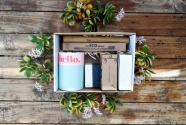
Green-Hot Fashion
It’s easy to dismiss fashion as frivolous. Whatever is touted as a season’s ‘must have’ or ‘the new black’ appears inconsequential when juxtaposed with real-world concerns like global warming, economic strife and famine. But beyond fleeting fads and mindless consumerism, clothing production can be accomplished in a better, smarter, and more socially and environmentally sustainable way. Oh, and you can still totally look hot while you’re being a good greenie.
It’s easy to dismiss fashion as frivolous. Whatever is touted as a season’s ‘must have’ or ‘the new black’ appears inconsequential when juxtaposed with real-world concerns like global warming, economic strife and famine. But beyond fleeting fads and mindless consumerism, clothing production can be accomplished in a better, smarter, and more socially and environmentally sustainable way. Oh, and you can still totally look hot while you’re being a good greenie.
Recent posts by Renée Leonard-Stainton
Sustainable fashion or ‘eco-fashion’ is a part of the growing philosophy and trend towards sustainability, with the aim being to create a system that can be supported indefinitely in terms of environmental and social responsibility. With fashion, it’s about making clothes that take into account the environment, the health of consumers and the working conditions of people in the industry. Sustainable clothes are made using organic raw materials grown without pesticides, such as cotton, bamboo and hemp. Production doesn’t involve the use of harmful chemicals and bleaches to color materials, and garments are often made from recycled and reused textiles or materials (yes, recycled plastic bottles have earned a place in high-fashion!)
The majority of clothing on the market is made from cotton, which is one of the most heavily sprayed crops in the world, accounting for 25% of the world’s insecticide use and 10% of its pesticides used. Synthetic options made from petrochemicals like nylon and polyester are no better: Nylon manufacturing creates nitrous oxide (a greenhouse gas which is 310 times more potent than carbon dioxide), while polyester demands large amounts of water for cooling, along with potentially toxic chemical lubricants. Both processes are energy hungry, which pushes them even further away from Camp Green.
Compare this to bamboo as a resource, which is sustainably grown, completely biodegradable, naturally pest and insect-resistant, and produces 35% more oxygen than trees! Luckily it’s the fastest growing plant in the world and its use in the fashion industry is swiftly soaring. Likewise, hemp is naturally insect-resistant, anti-microbial, and requires no herbicides, pesticides or chemical fertilizers to produce. It’s also completely legal.
The eco-fashion trend is about being super-stylish and conscious, responsible and earth-aware. Eco-fashion isn’t just about the fabrics used, it’s an ethos that translates throughout every aspect of a brand.
So, green is the new black. Thankfully, with the ‘new black’ seemingly changing faster than you can flick through a glossy fashion magazine, sustainable fashion is one trend that looks set to plant itself firmly on the fashion scene for years to come.
Live well, live long, live naturally
Renée x




Dear Renee
I found your website by accident as I was doing a ‘google’ search for ginger packs. It is so beautifully designed, I love the photos and fresh green colour. Also it is so great to see a friendly and approachable site with useful information which you don’t have to pay for/become a member/sign up etc. Thank you, Joanna from England